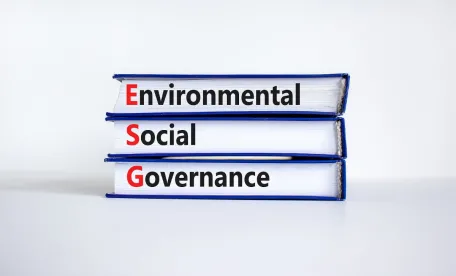The past few years have seen “ESG” — referring to environmental, social, and governance factors that influence decision making — move from being a fringe shareholder proxy issue to a front-of-mind C-suite issue.
The aim of the ESG movement is to use a broader base of information, stakeholder involvement, and forecasts to manage and price risks associated with factors that can be difficult to quantify but have an impact on the success of an endeavor now and into the future. The mix of issues to be addressed under the ESG umbrella range from treatment of employees, environmental impact, corporate sustainability, product marketing, and corporate board oversight. While each business might define ESG issues that are most impactful to its operations differently, to some degree, the corporate world has coalesced around the concept that ESG principles can help define business risk and identify solutions to countering risk. Given these big changes and given the frequent of litigation in the US to compel social policy change, we are certain to see litigation in the ESG space.
This post — focused on climate and the impact of emissions on climate — is the first in a planned multipart series discussing early litigation in the ESG space. We intend to chart common threads in litigation in various topic areas related to environmental, social, and governance issues. We begin first with climate- and carbon-focused litigation and — in coming weeks — discuss litigation in other areas including in circular economy and environmental justice.
An Abbreviated History of Climate- and Carbon-Focused Litigation in the US
Climate-focused litigation has a long predicate in actions to require the USEPA to regulate carbon dioxide emissions under the Clean Air Act (CAA). In recent years, the US Supreme Court made it clear with its decision in West Virginia v. EPA that congressional action would likely be required to directly regulate carbon dioxide emissions from sources like power plants under the Clean Air Act. (Our discussion of WV v. EPA is here.) Other attempts to regulate carbon dioxide directly under the CAA have floundered; a 2009 petition by two non-governmental organizations (NGOs) to have carbon dioxide established as a criteria air pollutant — adding it to a list with six others which are regulated under federal Nonattainment Air Quality Standards (NAAQS) — remained pending until 2021 when it was denied in the waning hours of the Trump Administration, only to be later revived for consideration by the Biden Administration.
Various “indirect” methods to regulate carbon dioxide emissions have yet to find meaningful success in US courts. These include suits alleging common law theories of nuisance seeking damages from energy companies related to sea level change (see Kivalina v. ExxonMobil here); claims brought by a class of children against the United States, alleging that federal environmental policy violated the “public trust” doctrine” (see our discussion of Juliana v. United States here, later dismissed by the Ninth Circuit here); or currently ongoing efforts by municipalities including Boulder and Baltimore to advance tort theories in state courts related to damages alleged to be tied to climate change.
NGOs have found the most fertile ground in challenging environmental permits and approvals. Environmental groups have sued under the National Environmental Policy Act (NEPA) and state-equivalent environmental review laws to challenge approvals for energy projects such as oil and natural gas pipelines, liquid natural gas terminals, and approvals or lease sales for oil and gas drilling. (See, e.g., here.) Plaintiffs in cases like this assert that the governmental agencies making the decisions failed to adequately consider the impact of climate change and the effect of greenhouse gas emissions from the project. Even so, these successes have been limited to date and none of these efforts has resulted in any significant changes in the overall environmental permitting and approval process.
ESG Litigation Related to Climate and Carbon Issues
As we discussed here, NGOs — and potentially state regulators dissatisfied with federal environmental regulations — may latch on to ESG disclosures to advance their political agendas. As climate- and carbon-related issues have been under increasing scrutiny, it is unsurprising that the first wave of ESG-related litigation claims consists of carbon- and climate-related claims.
Initially, these claims focused on allegations of securities law disclosure failures with a heavy focus on “greenwashing”. The most prominent case in this space is a complaint bought by the Massachusetts Attorney General against Exxon related to its climate disclosures. We wrote about this case in May 2022, after the Massachusetts Supreme Court allowed the claims to proceed. (See here.) The three-count amended complaint in this litigation alleges violations of Massachusetts state law stemming from Exxon’s alleged factual misstatements and failure to disclose information related to Exxon’s products and their impact on climate. Specific counts include:
-
that Exxon misrepresented or failed to disclose to investors material facts related to climate change and its impact on Exxon’s businesses;
-
that certain marketing and promotional materials misled Massachusetts consumers as to the climate impact of Exxon’s products; and
-
that Exxon was misleading Massachusetts consumers through so-called “greenwashing” campaigns — that Exxon’s advertising related to R&D work that emphasized technology advances to address climate change and reduce carbon dioxide emissions were in fact “puffery” made to influence purchasing decisions.
Similar suits have been filed by state officials in Connecticut, Minnesota, and New Jersey.
Other energy companies have faced corporate governance claims related to carbon issues, that is, that companies knew of potential environmental issues but chose not to address them. In 2016, Sempra Energy and Southern California Gas Company and various corporate officers were sued in a California derivative action based in part on an alleged one-million-barrels-of-natural gas a day leak from an underground storage facility. The complaint alleges that the leak was among the largest in US history and that the leak was “erasing years of progress made under California’s effort to overhaul its energy industry.”
Litigation Avoidance in This Context
ESG reporting has increased the visibility of ESG issues. Energy intensive industries — by their nature — are likely targets for climate-focused litigation claims. As one example, the Sabin Center for Climate Change Law’s US Climate Litigation Tracker lists nearly three dozen separate cases involving Exxon.
The risk minimization strategies of ESG also give rise to the information that can become the focus of claims related to the accuracy of disclosures or the intent of the company’s actions revealed in disclosure reports. Companies can take steps to minimize the risk of climate-related litigation. Of course, the most important is to ensure that all disclosures in sustainability and other public reports are accurate and verifiable and strike the appropriate balance between aspiration and actuality. Oversight by appropriate specialists can ensure the highest level of integrity is maintained in disclosures related to climate risks. Remaining aware of upcoming changes in the Federal Trade Commission’s “Green Guides” (see here), which provide guidance regarding environmental marketing claims is another key step. Those seeking permits and approvals can reduce the risk of litigation involving a critical permit or approval by ensuring the issuing agency thoroughly reviews climate change and other ESG issues during the permitting process, and documents its findings as part of the administrative record.
Steps perhaps not as obvious are these:
-
Being aware of the stakeholders or NGOs within your operations territory;
-
Remaining aware of litigation trends, both inside and outside of the ESG space.
-
Ensuring that data, including digital advertising, used to attract customers properly expresses corporate policies, data and intentions. As one example, “net zero” claims – presenting plans that a company will have no carbon dioxide emissions in the future – are likely to occasion litigation against various entities in the coming years.





 />i
/>i

